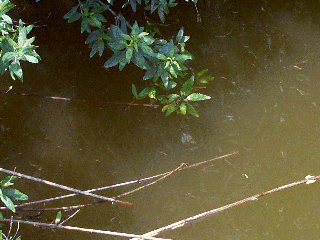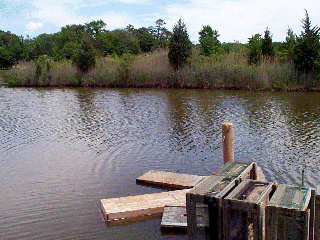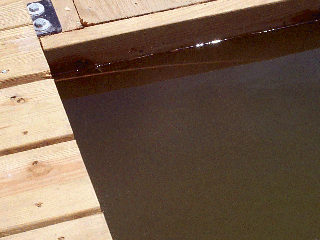
Using the plants at the side of the lagoon |
Posted 6/17/99 |
||
Anglers have a number of questions that
they've been running past us. Most of what I found was more questions,
but I'll do the best I can (I'm certainly no biologist :) ) Scott's
been teasingly calling this my "doctoral thesis" but it is pretty
interesting!
1-"Is it dangerous?"
You can read more about them via the links at the bottom of the page if you are interested. Brown tides are not known to produce any kind of neurotoxins. The brown algae in large numbers absorb much of the oxygen in the water, as well as causing that thick cloudy effect that can hurt the tiny marine plants if present for a long period of time. Loss of plants can have a long term effect of reducing the number of young fish, which can mean a shortage of fish in Great/Barnegat Bay's future if it stays all summer. The algae also affects the growth of shellfish, such as clams and scallops. They stop feeding, so they stop growing. "What is it?" What
we apparently have here is Aureococcus anophagenfferens or similar
algae, forming what is commonly called a Brown Tide. I found out
that there are several different kinds of algae "tides" and that they vary
in degrees of severity/toxicity (see "Is it dangerous?").
The algae go through prosperous periods where they "bloom", sometimes spanning
large areas of water, as they are doing here in our lagoons and bay waters.
We've heard that areas of Barnegat Bay are also affected. "Blooming"
simple means that the population of algae has grown so thick that the waters
are full of clouds formed by the microscopic creatures/plants.
"What caused it?" Here's where we run into more questions! There are many theories as to why the algae suddenly bloom in such great numbers. Two of them are listed below: They occur annually as a natural phenomena, and have for centuries. Usually the algae are not so widespread, and it clears out fairly quickly. The biologists are still studying them to find out why they sometimes increase in numbers and duration. One of the sources I found (links listed at bottom of page) said that they might be self perpetuating as well. Sediments caused by dying algae may feed the surviving algae.* Sudden temperature changes of the shallower waters---which we definitely encountered this spring, first by warming too quickly, then dropping again to cooler temps. "What is it's effect on fishing?" There has been a definite drop-off in fishing during the last two weeks that the water has been cloudy. The lack of oxygen due to the high concentration of algae is most likely make some of the fish, like the Fluke, sluggish. They may have moved out to clearer waters, as well. Weakfish were still biting well in the areas of Little Sheepshead Creek and Grassy Channel during dusk and dawn. The NE weather we've been experiencing for the past two days has slowed that fishery down a bit. Need a recommendation for fighting the presence of the brown tide? The water is cloudy------make sure your lures and baits are highly visible! Brightly colored bucktails, worms, and plugs will definitely increase the chances of catching a fish. They surely won't bite it if they don't notice it! "When is it going away?"
This is a definite unknown. The longer the area waters stay cloudy,
the more damage that will be done to the local wildlife. Fishing
and clamming both will be at risk-fish will move out, shellfish will stop
growing.. There are hopes among the locals that a good storm might
blow out the algae, or at least bring in enough water to break it up or
disperse it entirely.
|
|||
|
The Clean Water Initiative: http://cleanwater.gov/ |
|
 |
Sites about algae tides: |
| http://www.mote.org/~pederson/phyto_ecol.phtml | |
| NOAA HAB: http://www.cop.noaa.gov/projects/HAB.htm | |
| Trent Schneider "Brown Tides" http://www.udel.edu/CIB /cstlines.html | |
| Univ.System of Maryland "Brown Tide Blooms" http://www.som1.ab.umd.edu/AquaticPath/toxalg/btb.html | |
 |
Red Tides/Toxic Tides: |
| SEAWEB:http://www.seaweb.org | |
| Rebecca Collier: "Toxic Tides" http://www.vnm.com/~mcollier/toxtide.html | |
| S.T.A.R.T.: http://www.start1.com/start.htm | |
Return to Wildlife/Conservation Page

